Unveiling Ireland’s Enigmatic Weather Lore and Strange Myths: The Whispering Winds

Updated On: April 22, 2024 by Fatma Mohamed
Nestled within Irish folklore lies a rich tapestry of weather lore, intertwining the forces of nature with the mystical. Ireland’s ancient inhabitants revered the land and its weather patterns, creating an enduring narrative of mythological power and supernatural influences. These tales speak to the entwined relationship between the Irish people and their environment, shaping a cultural understanding of the world around them that has lasted through the centuries.
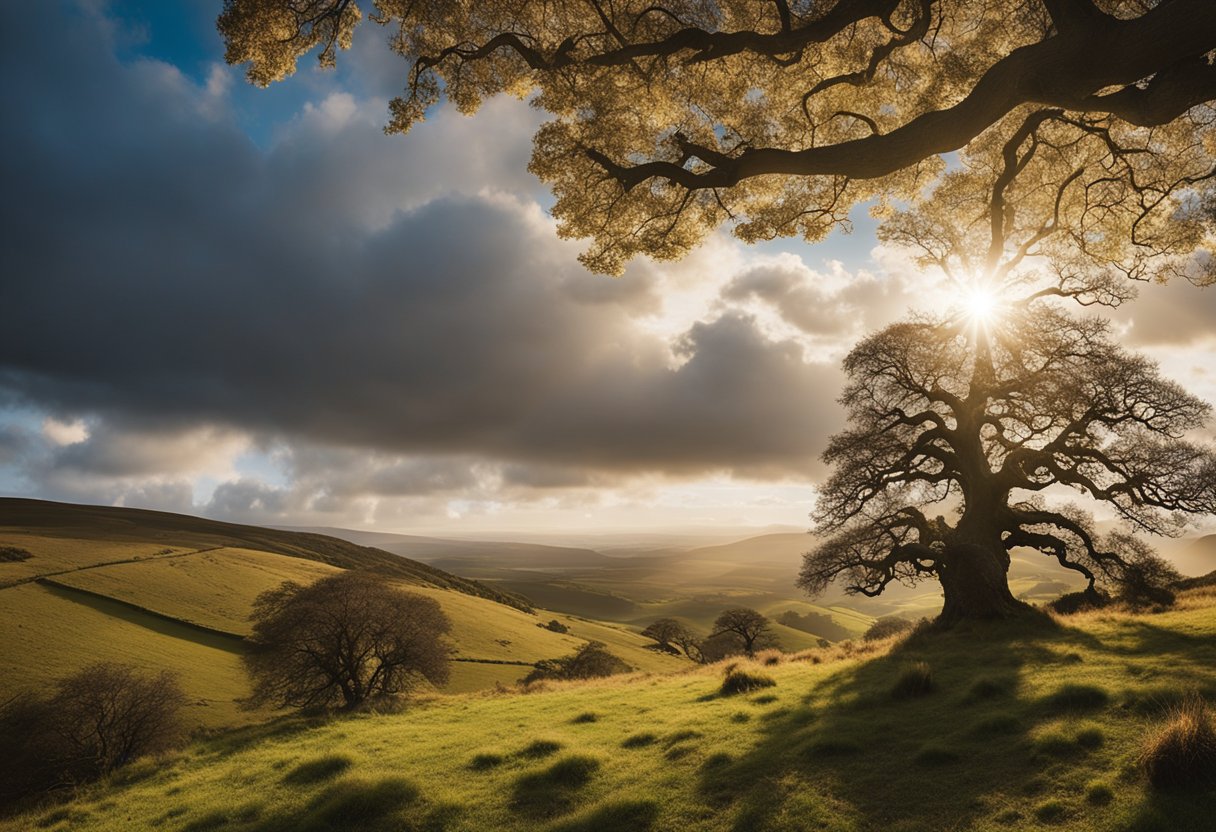
Irish mythology brims with stories where weather phenomena play pivotal roles. The whispering winds, in particular, carry the secrets and whispers of the past, often heralding change or signalling the presence of otherworldly beings. Such legends are not just fanciful stories; they embody the Irish way of making sense of the unpredictable weather and its impact on their lives.
Table of Contents
Origins of Irish Mythology
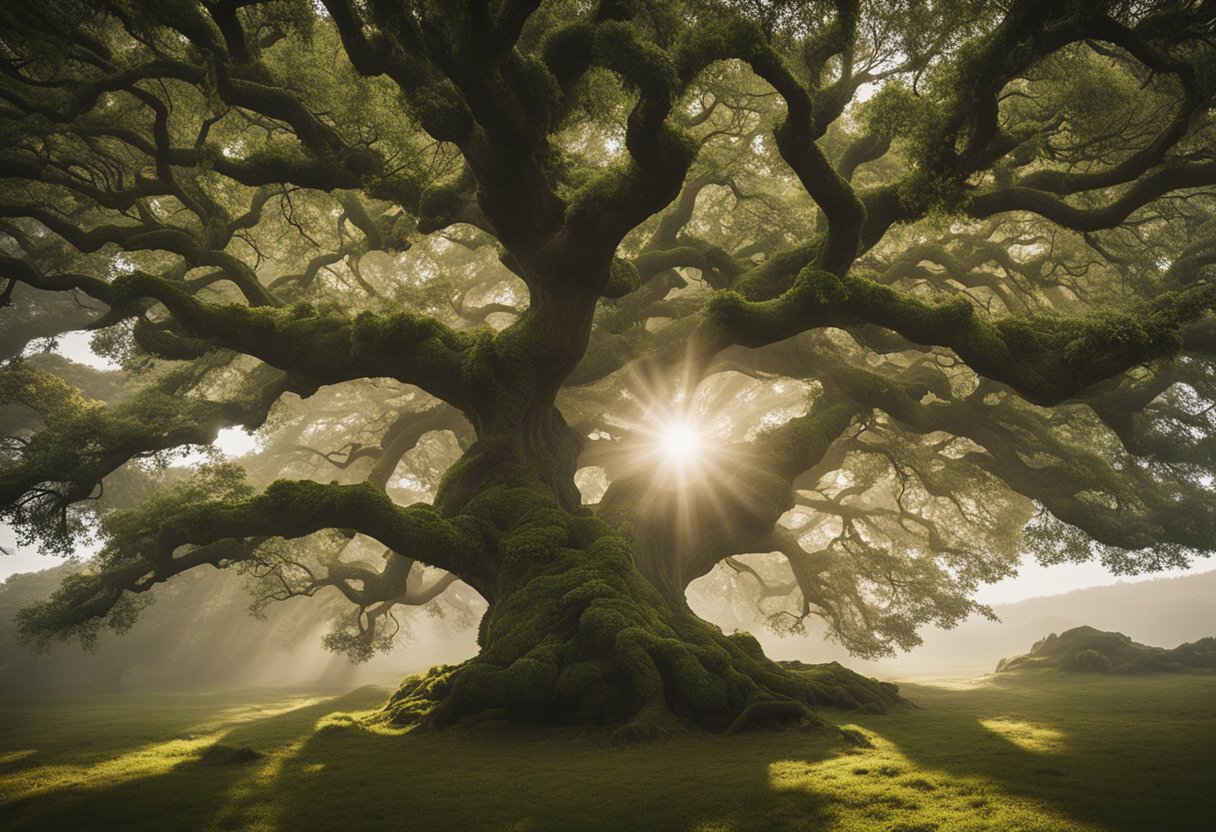
Irish mythology, encapsulating the beliefs and legends of ancient Ireland, finds its roots intertwined with historical facts and mystical tales. The subject is particularly rich, comprised of several cycles, each detailing a unique aspect of the island’s past and its people. Two prominent cycles that stand at the foundation of this lore are the Mythological Cycle and the Historical Cycle, both chronicling the arrival and impact of key figures like the Tuatha Dé Danann and the Mileisans.
Mythological Cycle
The Mythological Cycle, also known as the Cycle of Gods, captures the earliest era in Irish lore where supernatural entities and deities reigned. At the core of these stories are the Tuatha Dé Danann, a group of divine beings who, according to legend, descended from the heavens to inhabit Ireland. They were said to be the progeny of the Goddess Danu, manifesting formidable magical abilities and knowledge of ancient arts.
One significant figure among them was The Dagda, a god known for his power and prowess. These deities were believed to have brought with them four magical treasures that epitomised their command over the elements and were integral to their dominance in Irish mythology.
Historical Cycle
Turning to the Historical Cycle, or the Cycle of Kings, we find a chronicle of semi-mythological and historical narratives. This body of work tells of the heroic deeds and the rise and fall of dynasties. The depiction of the Mileisans, a tribe of people from the Iberian Peninsula, marks a significant event within this cycle, giving an insight into the purported mortal ancestors of the Irish.
The battle between the Mileisans and the Tuatha Dé Danann culminated in the latter retreating into the fairy mounds, leading to the human occupation of Ireland. This transition is vital to the understanding of Irish mythology as it blends the mythological with the historical, revealing a dynamic evolution of Ireland’s cultural and societal structures through its storied past.
Gods and Supernatural Beings
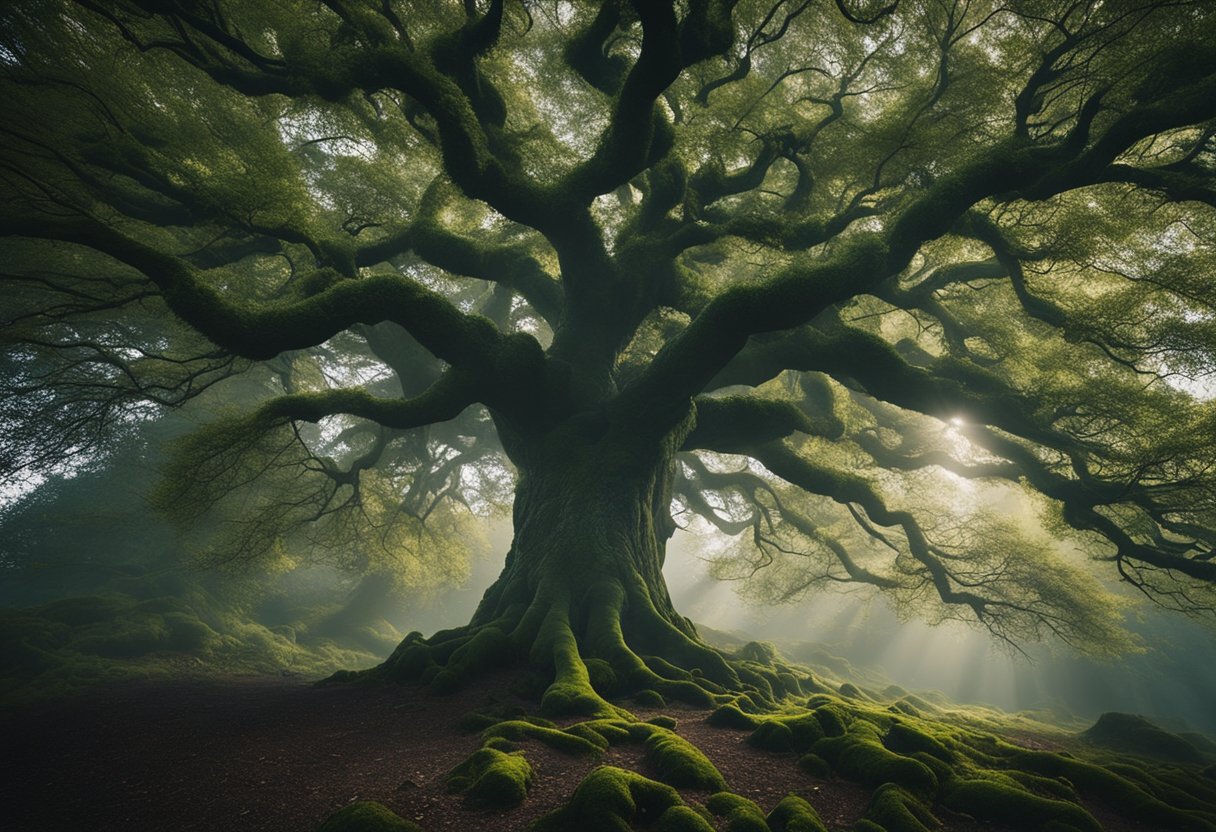
In our exploration of Ireland’s mythological weather lore, we encounter an array of deities and mystical entities that embody the forces of nature and the supernatural world. These figures, revered in Irish folklore, play a fundamental role in shaping the island’s weather patterns and narratives.
Tuatha Dé Danann
The Tuatha Dé Danann, translated as the “Tribe of the Goddess Danu,” are a legendary race of divine beings in Irish mythology. The chief among them, The Dagda, embodies the aspects of life and death, being a god of fertility, agriculture, and strength. His attributes include a massive club and a cauldron that never runs empty, symbolising abundance and protection. Lugh, a master of skills, also belongs to this pantheon and is associated with the harvest festival, Lughnasadh, marking the beginning of the harvest season.
Another central figure is The Morrígan, often represented as a trio of sisters who are associated with fate and sovereignty. She takes on the role of a war deity, prognosticator, and influencer of the land’s well-being. Her influence over the winds and weather is often invoked in tales and sagas, where she appears in various forms, sometimes as a hooded crow, patrolling the battlefield.
Otherworld Inhabitants
In the Otherworld, an ethereal plane of existence beyond the human realm, reside numerous other supernatural entities. Here, figures such as Aengus, the god of love and youth, son of The Dagda, is famed for his poetic nature, weaving spells with his words that could calm or stir the winds. It is from this Otherworld that many mythological Irish weather phenomena are said to originate, interwoven with the lives and tales of these deities and beings.
These gods and supernatural inhabitants, interlacing with the forces of nature, play a pivotal role in Irish weather lore, each manifesting their power and peculiarities through the whispering winds and the changing climates of Ireland’s landscapes.
Legendary Heroes and Warriors
In tracing the whispering winds that carry tales of yore, we turn our gaze to the Emerald Isle, where legendary heroes and warriors are etched into every gust. These figures exemplify the spirit, courage, and complexities of ancient Irish lore.
The Fianna
The Fianna were a band of noble warriors whose legends are central to the Fenian Cycle of Irish mythology. Led by the eminent Fionn mac Cumhaill, these warriors were bound not only by their prowess in battle but also by their commitment to protect the High King of Ireland. The Fianna were synonymous with the attributes of strength, wisdom, and kinship, exemplifying the model of warrior-citizens in Irish folklore.
Ulster Cycle Heroes
The Ulster Cycle boasts of heroes whose tales are woven into the very fabric of Irish cultural identity. Their stories resonate with the exploits and fates that both inspire and caution. Cú Chulainn, the central hero of this cycle, stands out as the epitome of heroism, known for his superhuman abilities and tragically beautiful devotion to his duty. This was a warrior who could unleash the ‘warp spasm’, transforming into an unrecognisable monster in battle, yet he is equally revered for his vulnerable, human side, which endeared him to the hearts of those who hear his tale.
Sacred Sites and Artefacts
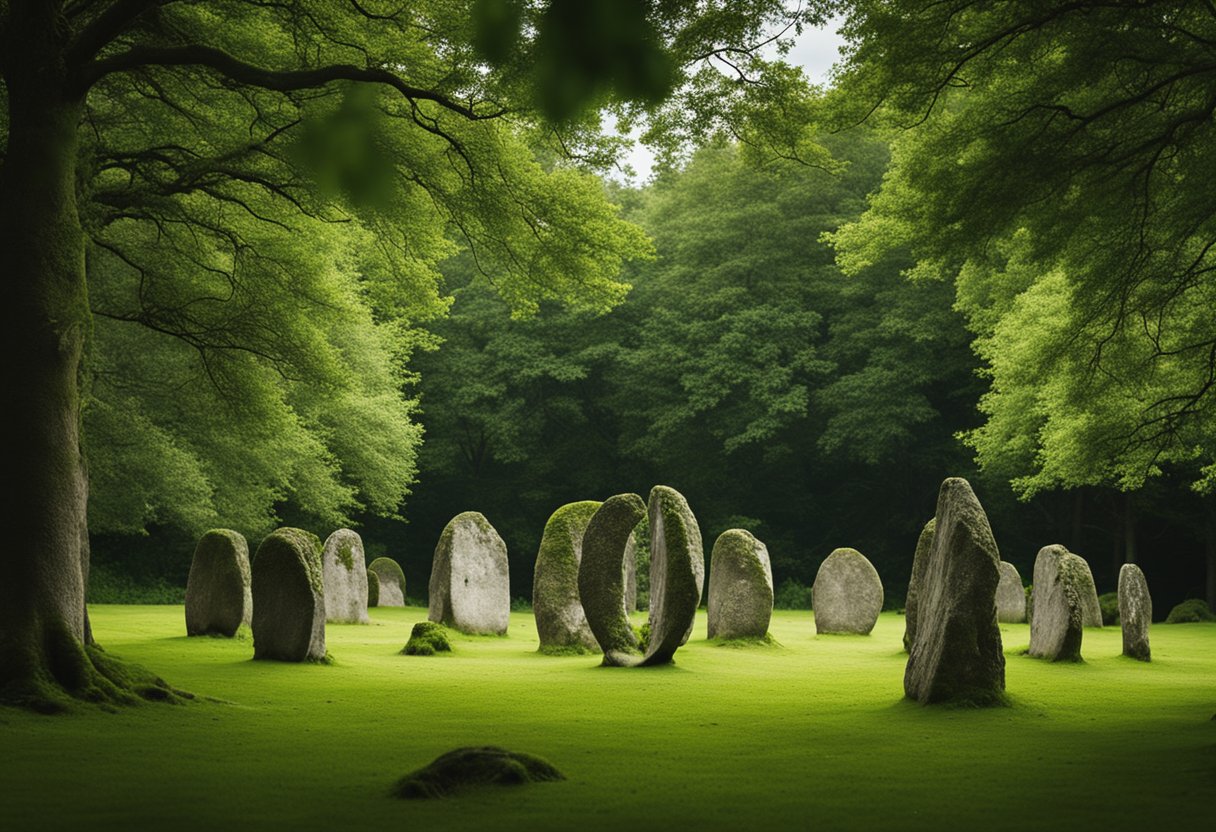
In exploring Ireland’s rich tapestry of myth and legend, we come across sacred sites and artefacts that weave a narrative of the land’s ancient past. These places and objects not only embody the esoteric wisdom of the Celts but also hold the whispers of Ireland’s weather lore, where the natural and supernatural worlds intertwine.
Celtic Art and Symbolism
The intricate weaves of Celtic art and symbolism are not merely for adornment but are steeped in meaning, often reflecting natural patterns and celestial movements. The interlacing knots found on stones and jewellery have no beginning or end, reminiscent of the eternal cycle of life and the forces of nature that govern the land. For instance, the revered Salmon of Knowledge is a symbol of wisdom, encapsulated in numerous artefacts, suggesting the Celts’ deep respect for creatures they saw as keepers of knowledge.
Mythological Curiosities
Among Ireland’s array of mythological curiosities, the Giant’s Causeway stands supreme. It is said that this stunning formation of basalt columns is the remains of a causeway built by the giant Finn McCool. Venturing into such places, we’re reminded of the legends that sprung from Ireland’s dramatic landscapes, invoking a sense of enchantment that has been carried through generations. This connection between land and lore is ever-present, adding a mystical dimension to our natural heritage.
In essence, our heritage sites are not just stone and soil; they’re living repositories of storytelling, where every artefact holds a piece of the puzzle in Ireland’s mythological saga.
Influences on Irish Culture

Ireland’s rich tapestry of weather lore and mythical stories has long permeated various facets of Irish culture, from the oral tradition to literature. These narratives often encapsulate the intertwined relationship between the natural environment and the cultural identity of the Irish people.
Mythology in Literature
Irish mythology has manifested itself strikingly within our national literature. Legends of the Tuatha Dé Danann, as keepers of wisdom and magical skills, are meticulously chronicled in texts such as the iconic Book of Invasions. This collective memory, transmitted through oral tradition, has been instrumental in shaping Ireland’s literary voice. The weather in Irish folklore, embodying the capriciousness of the skies, frequently cascades into the themes of our literary canon, illustrating the powerful sway of these ancient tales on authors and poets throughout centuries.
Myths in Modern Culture
In contemporary society, ancient myths have found new expression in diverse forms of cultural output. They are not mere relics of a bygone era but continue to wield influence in modern artistic and cultural representations. By intertwining myth with present-day issues, artists and creators breathe new life into these stories, ensuring their enduring relevance. Films, music, and even digital media have become fresh canvases for these age-old narratives, evidencing the immutable bond between the mythological and our ongoing cultural evolution. From Irish culture’s depiction in global media to its impact on local customs, these deep-rooted legends perpetuate the enchantment of Ireland’s heritage.
Our language and expressions, enriched by centuries of oral tradition and shared stories, vividly reflect this phenomenon. The whisper of the Irish wind carries more than just weather; it conveys the whispers of our ancestry, infusing daily life with a sense of continuity and connection to the past.
Natural Phenomena and Weather Lore
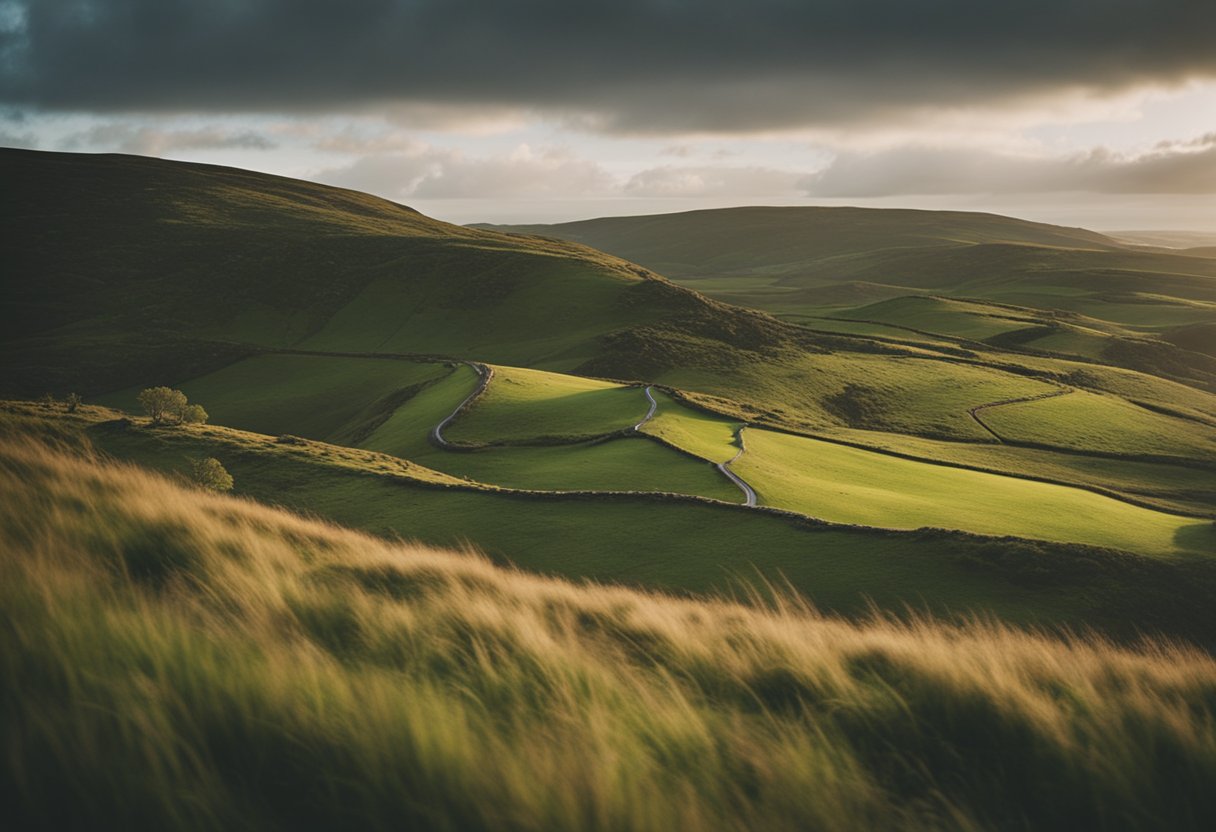
In the rich tapestry of Ireland’s mythological weather lore, natural phenomena are often seen as omens or messengers from the otherworld. Our ancients observed the world around them with keen interest, imbuing the natural events with significance that still whispers to us today.
Whispers of the Land
The patterns and behaviour of the land serve as a traditional barometer for weather predictions. A simple example is the belief that when the mist descends upon the hills, rain is on the horizon. In times past, we perceived the land’s moods, noting that a harsh change in wind often warned of a storm brewing, this was the land speaking to us, forecasting what was to come.
Sea and Sky
Our ancestors were adept at reading the sea and sky. An old weather saying goes, ‘When the sky is grey, and the sea is white, we’ll be drenched by the morning light.’ The Irish coastline and the surrounding seas were particularly important for the fishing communities. An unexpectedly calm sea was sometimes considered an omen of a brewing tempest that required caution.
Flora and Fauna
The flora and fauna of Ireland have their own tales to tell. It was observed that the behaviour of animals often predicts the weather. An owl calling during the day, for instance, was considered an omen of bad weather. Plants, too, like the clover closing its leaves, could signal an impending downpour, providing us with a natural warning system entrenched in our lore.
Life, Death and the Afterlife

In Ireland’s mythological weather lore, the intertwining of life, death, and the afterlife is often whispered on the winds that sweep across the land. These tales are a testament to the rich tapestry of beliefs that envelop the Irish psyche, touching upon the mystical realms that lie beyond our mortal grasp.
Rituals and Burial Customs
We uncover the solemn respect with which the dead are treated, evident in the elaborate burial customs that have stood the test of time. The Irish grave sites, with their Celtic crosses and enigmatic inscriptions, serve as portals to an ancient world where rituals were performed to honour those who have passed. Traditional wake ceremonies were a blend of mourning and celebration, believing that the deceased’s spirit was embarking on a journey to the otherworld.
Legends whisper of the banshee, a fairy spirit whose mournful wail is believed to herald an impending death. Renowned in lore for her connection to certain families, her cry serves as a preternatural omen that binds the world of the living to the spectral plane.
Tír na nÓg and Immortality
Tír na nÓg, translated as the ‘Land of the Ever Young’, shimmers in Irish mythology as a realm where the fairy folk reside and where age and death hold no sway. The enchanting tales depict an eternal place of youth and happiness, disconnected from the mortal world, where time loses its meaning.
The allure of Tír na nÓg has captivated the hearts of many, entwined with stories of heroes and mortals who, seeking to attain immortality, ventured into this otherworld. It echoes an intrinsic yearning for a blessed existence that lies just beyond the final breath, immortality, where one’s spirit dances forever on the emerald isles.
Legendary Battles and Conflicts
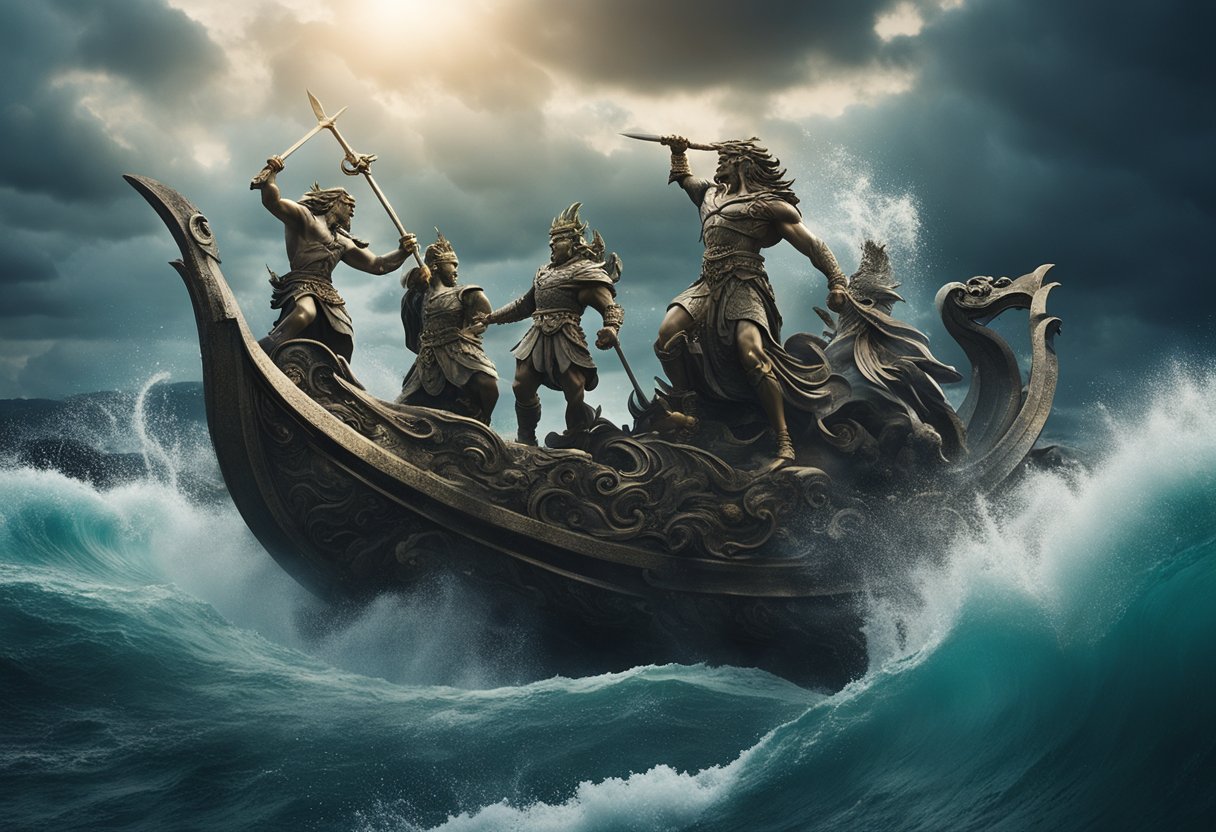
In the tapestry of Ireland’s mythology, storied battles and fierce quests for sovereignty often intertwine with the elements, as if the very winds whispered sagas of ancient conflicts and heroics.
Cattle Raid of Cooley
One of the most eminent tales from Irish myth is the Táin Bó Cúailnge, commonly referred to as the Cattle Raid of Cooley. This epic narrative centres on a grand skirmish spurred by the desire to possess the fabled brown bull of Cooley—symbolising wealth and status. Queen Medb of Connacht and her consort Ailill launched this formidable campaign against the forces of Ulster, resulting in a series of clashes famously narrated in the Ulster Cycle. The hero Cú Chulainn, standing for Ulster, single-handedly thwarts enemy advances, manifesting as a testament to the legendary warrior’s prowess.
Struggles for Sovereignty
Ireland’s mythic chronicles also recount numerous Struggles for Sovereignty, often encapsulated by the trials to secure the title of High King of Ireland. Legend narrates how the mystical Tuatha Dé Danann contested with earlier inhabitants, leaving an indelible mark on the land through their victories and defeats. The First Battle of Magh Tuireadh exemplifies such conflict, where the Tuatha Dé Danann’s magical supremacy ultimately led them to triumph over the Fir Bolg, illustrating a broader cosmic struggle for dominion over Ireland.
These ancient stories, cascading from one generation to the next, are rich with the echoes of clashing swords, the roar of warriors, and the determination of those seeking to control the fate of the Emerald Isle.
Kinship, Clans, and High Kings
We’re exploring an integral part of Ireland’s mythological heritage: the intricate networks of kinship and clans, along with the powerful High Kings that ruled over them.
Royal Families
Irish society in ancient times was deeply interconnected with kinship, forming strong clans or family groups. At the heart of these clans were the royal families, whose lineages were traced through generations. The leadership of these clans was typically held by the kings, who were key figures in maintaining the family’s status and power within the region. It was not uncommon for several smaller clans to be ruled by a more dominant one, reflecting a hierarchy among the royal families themselves.
Dynastic Strife
Within this complex societal framework, disputes often arose, leading to dynastic strife. Such conflicts could be rooted in battles for succession, territorial disputes, or the desire for greater power among ambitious members of royal families. The title of the High King of Ireland was coveted, with numerous kings aspiring to claim it. However, achieving and maintaining the status of the High King was fraught with challenges, as it involved gaining the allegiance of the fractious clans and often resulted in a tumultuous reign.
The Transmutation of Myths Over Time
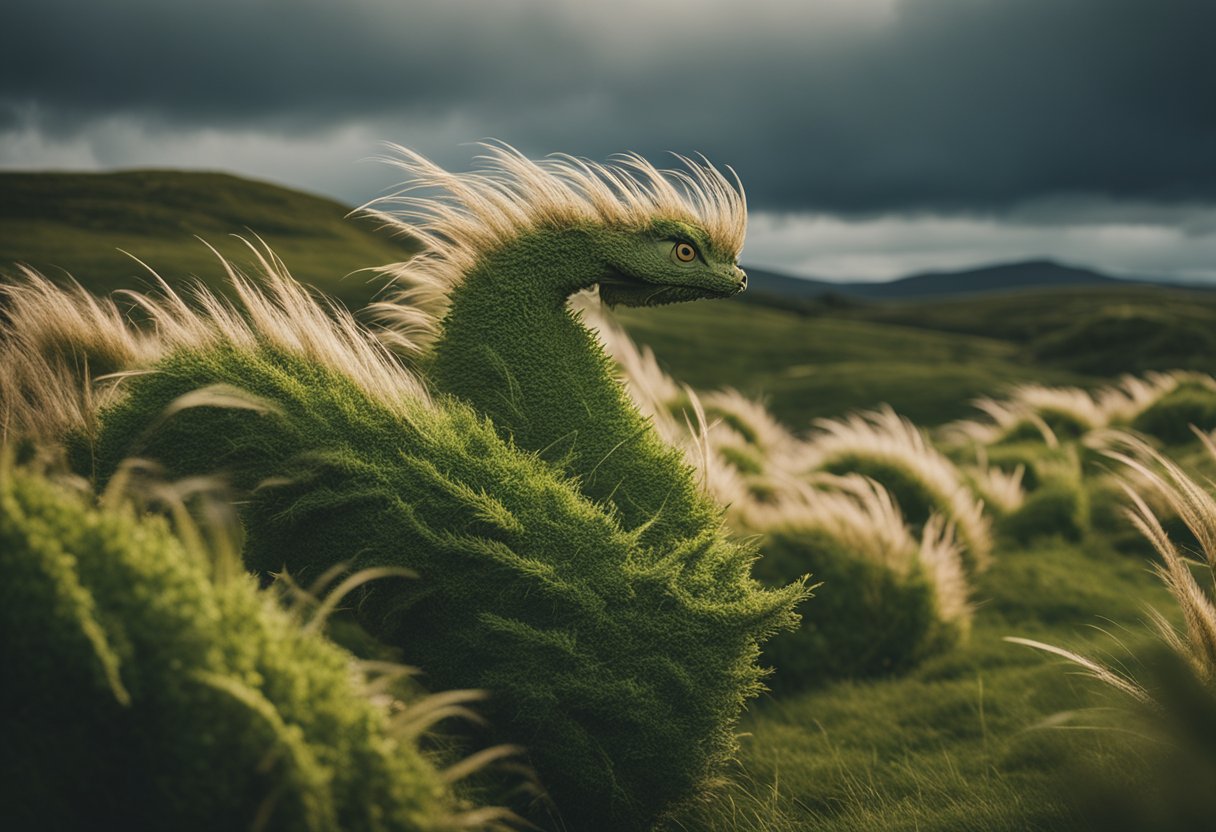
As custodians of our cultural heritage, we recognise how Ireland’s mythological weather lore has undergone significant changes throughout history. Within these shifts, key narratives have been reshaped, often integrating seamlessly with changing societal beliefs and practices.
Integration with Christian Narratives
In the passage of time, pagan myths in Ireland found new life within the domain of Christianity. St. Patrick, a figure synonymous with the Christianisation of Ireland, featured prominently in this transformation. Early Christian monks, tasked with chronicling history, adeptly wove the saint into local legends, marking divine influence over Ireland’s natural phenomena. This assimilation did not overshadow the old gods; rather, it formed a syncretic tapestry of belief, where Christianity complemented pre-existing lore, breathing new resonance into ancient narratives.
Mythological Adaptation and Survival
The longevity of Ireland’s myths can be attributed to their incredible adaptability. Weather deities and whispering winds found their essential essence preserved even as the outer shell of the stories conformed to prevailing historical contexts. It is this resilience that has safeguarded such myths, allowing them to persist as cherished oral histories and, later, as literary accounts. Intertwined with the very elements they describe, these tales have withstood centuries, surviving as a testament to Ireland’s rich and enduring cultural history.
Frequently Asked Questions
In this section, we address some of the most commonly asked queries about Ireland’s rich tradition of weather lore, focusing on the key roles that wind and changing seasons play within its mythology.
What significance does wind have in Irish folklore?
Winds in Irish folklore are often seen as messengers and bearers of change, carrying whispers from the otherworld. They’re integral to many legends, where a sudden gust might signal the presence of the supernatural or the beginning of an epic tale.
Can you list some legends associated with Irish weather lore?
Certainly, legends such as the enchantment of Ireland’s Talking Trees intertwine with weather lore, where the trees communicate with each other and the world around them through the wind. Tales of the pooka, a shape-shifting creature of the night, also often involve the elements, typically emerging in the rush of a wild, windy night.
Who are the prominent figures in Irish weather mythology?
Key figures include the likes of Manannán mac Lir, the god of the sea, who is also associated with the weather, as he commands the mist and the sea winds. The Cailleach, or the ‘veiled one’, is another powerful figure, often considered a divine hag who controls the winter weather.
Which tales from Irish folklore involve seasonal changes, particularly winter?
One of the most poignant tales is that of the Cailleach, who is said to usher in the winter. Her influence over the land during winter months is a testament to how Irish folklore integrates the profound impact of seasonality on life.
How do Irish myths personify the elements, especially the wind?
Irish myths often give a voice to the wind, using it as a narrative device to herald the arrival of deities or to foretell changes. It is personified as a living entity, filled with the spirits of ancestors or otherworldly beings, omnipresent and powerful.
What tales of Irish hounds feature in the country’s mythology?
The mighty hounds of Irish mythology feature prominently, such as in the story of Bran and Sceolan, the hounds of Fionn mac Cumhaill, which are entwined with magic and transformation—themes that frequently recur in our mythological weather lore.






